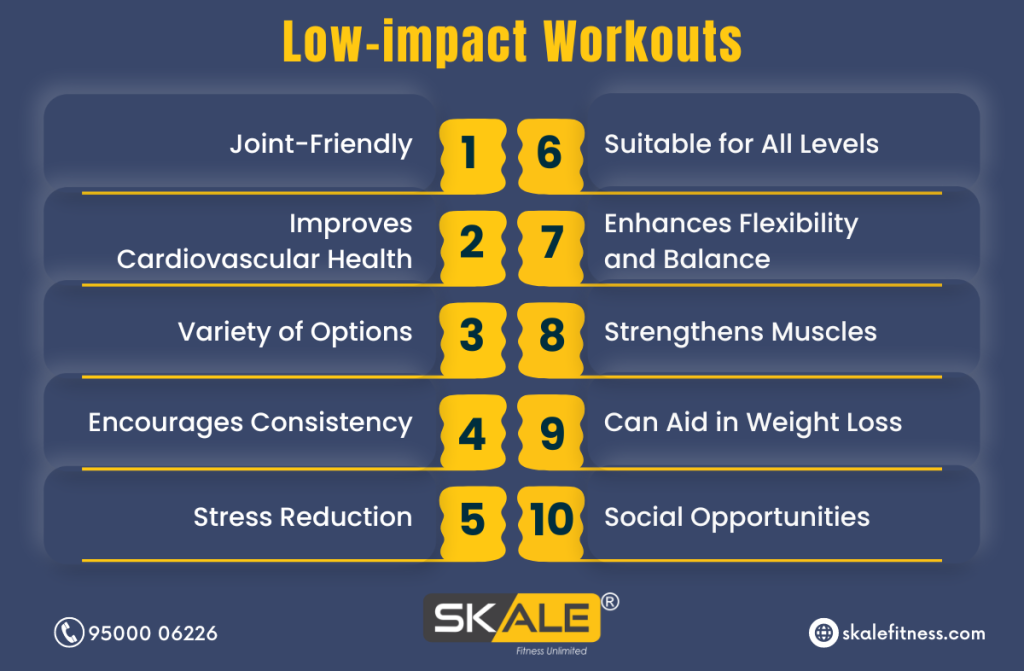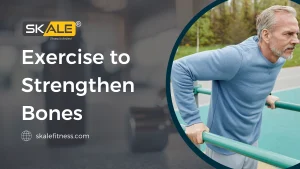Staying active is crucial for people of all ages, and seniors are no exception. However, as we age, our bodies may become more susceptible to injuries and strain, making high-impact workouts less suitable. This is where low-impact workouts for seniors come into play. These exercises are gentle on the joints, yet effective in promoting cardiovascular health, muscle strength, and overall well-being. The benefits of low-impact workouts and provide a variety of exercises tailored to seniors’ needs.
What are Low-Impact workouts and Exercise?
Low-impact workouts and exercises are forms of physical activity that minimize stress on the joints and reduce the risk of injury. These activities involve less intense, jarring movements compared to high-impact exercises. Examples of low-impact workouts include walking, swimming, cycling, and elliptical training.
These activities are gentler on the joints, making them suitable for individuals with joint issues, arthritis, or those recovering from injuries. Low-impact exercises are beneficial for promoting cardiovascular health, improving flexibility, and aiding in weight management, making them an excellent option for people of various fitness levels and ages.

The Importance of Low-Impact Workouts for Seniors
Engaging in regular physical activity is key to maintaining good health, especially as we age. Low-impact workouts for seniors are designed to minimize stress on the joints, reduce the risk of injuries, and improve overall mobility.
These exercises are ideal for individuals with arthritis, osteoporosis, or other conditions that may limit their range of motion. By incorporating low-impact exercises into their routine, seniors can enhance flexibility, balance, and muscle strength without putting undue strain on their bodies.
Gentle Cardiovascular Exercises
Cardiovascular health is essential for seniors, and low-impact exercises can provide an effective way to boost heart health without causing excessive stress. Brisk walking, swimming, and cycling are excellent choices for weight loss looking to improve their cardiovascular fitness. Low-impact workouts for seniors, such as a brisk walk around the neighborhood or a leisurely swim, can make a significant difference in maintaining a healthy heart and circulation.
Strength Training for Seniors
Maintaining muscle mass is crucial for seniors to support daily activities and prevent falls. Low-impact strength training exercises help build and tone muscles without subjecting joints to excessive pressure. Bodyweight exercises, such as squats, leg lifts, and wall push-ups, are great options for seniors. Incorporating resistance bands or light weights can add an extra challenge without compromising safety.
A carefully crafted low-impact workouts for seniors that includes these strength-building exercises can contribute to improved muscle tone and overall strength.
Flexibility and Balance Exercises
As we age, flexibility and balance become increasingly important to prevent falls and maintain functional independence. Yoga and tai chi are excellent low-impact activities that focus on flexibility, balance, and relaxation. These exercises help seniors improve their range of motion, enhance coordination, and reduce the risk of injury. Short low-impact workouts for seniors can include simple yoga poses or tai chi movements, promoting flexibility and balance in a gentle manner.
Incorporating Low-Impact Workouts into Daily Life
Making low-impact exercises a part of daily life is key to reaping the full benefits. Simple activities such as gardening, gentle stretching, or taking the stairs instead of the elevator can contribute to overall fitness. Seniors can break down their exercise routine into shorter, manageable sessions, aiming for at least 10 minute low-impact workout for seniors of activity at a time.
By finding enjoyable low-impact activities and gradually increasing their duration, seniors can make exercise a sustainable and enjoyable part of their daily routine.
Best Low-Impact Exercises for Seniors
- Seated Leg Lifts
- Purpose: Strengthens lower body, aids in daily activities.
- How to Do It: Sit in a sturdy chair, feet flat and back straight. Lift one leg straight out, parallel to the floor, hold for 10 seconds, then slowly lower. Repeat on the other leg, aiming for 10-15 lifts per side.
- Wall Push-Ups
- Purpose: Enhances upper body strength for daily independence.
- How to Do It: Stand facing a wall, feet hip-width apart, hands on wall at shoulder height. Lean in, bending elbows, then push back. Aim for 10-15 repetitions.
- Gentle Neck Stretches
- Purpose: Reduces neck tension and discomfort.
- How to Do It: Stand or sit straight, tilt head to one side, ear towards shoulder, hold 15-30 seconds. Repeat on other side, doing 2-3 stretches each.
- Chair Squats
- Purpose: Improves leg strength, balance, and stability.
- How to Do It: Stand in front of a chair, feet hip-width apart. Simulate sitting, hover above chair, then stand. Aim for 10-15 repetitions.
- Arm Circles
- Purpose: Increases shoulder mobility and strength.
- How to Do It: Stand with feet shoulder-width, arms extended at shoulder height. Make small circles, gradually increase size, switch direction after 10-15 seconds. Repeat for 2-3 sets.
Tips for Seniors Starting a New Exercise Routine
- Consult with a Doctor: Before starting any new exercise program, it’s important for seniors to consult with their healthcare provider to ensure the activities are safe and appropriate for their individual health conditions.
- Start Slowly: Begin with shorter sessions and gradually increase the duration and intensity of the workouts. This helps prevent injury and allows the body to adapt to the new activity levels.
- Stay Hydrated: Proper hydration is crucial, especially during physical activity. Seniors should drink plenty of water before, during, and after exercise.
- Listen to Your Body: Pay attention to how your body feels during and after exercise. If you experience pain, dizziness, or shortness of breath, stop immediately and seek medical advice if necessary.
- Wear Appropriate Footwear: Comfortable, supportive shoes can help prevent falls and provide the necessary support for various types of exercise.
Conclusion
Incorporating low-impact workouts for seniors routine can significantly improve their overall health and well-being. Whether it’s cardiovascular exercises, strength training, or activities focused on flexibility and balance, there are numerous options tailored to the unique needs of seniors. A 10 minute low-impact workout for seniors can be a great starting point, gradually increasing in intensity and duration as they become more comfortable. It’s never too late to prioritize fitness, and by choosing low-impact exercises, seniors can maintain an active lifestyle without compromising their joint health.
Also, Read Best Gym in Chennai.





